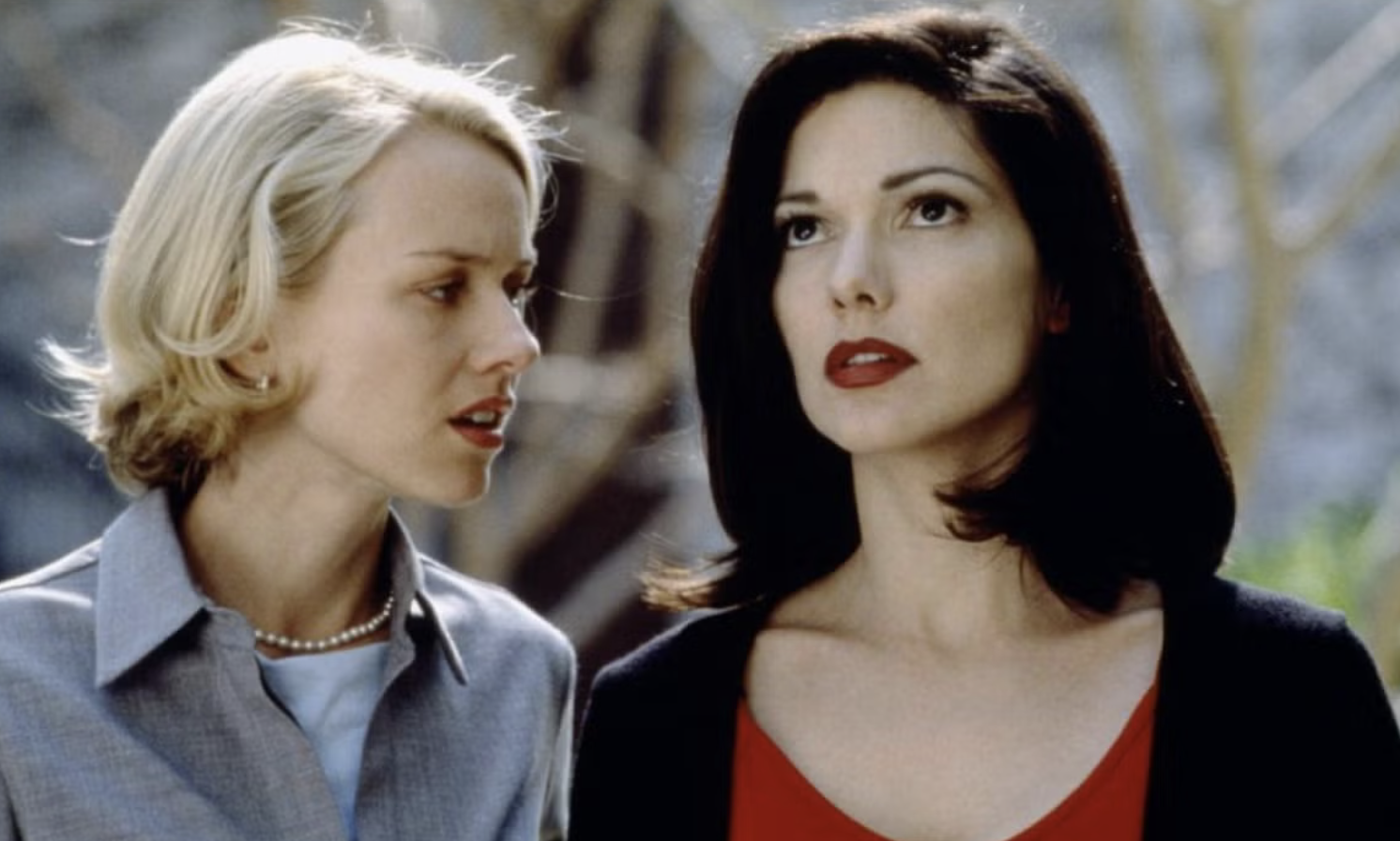When David Lynch released Mulholland Drive in 2001, audiences staggered out of theaters like survivors of a beautiful car wreck. The film’s dreamlike logic, nonlinear structure, and surreal unease turned Hollywood itself into a haunted house where ambition and identity blur. And at the heart of this fractured nightmare stands Laura Harring — luminous, unknowable, and terrifyingly human. As both Rita, the amnesiac reborn after a car crash, and Camilla Rhodes, the successful actress and object of devastating desire, Harring embodies not two separate characters but two halves of the same psychological wound. Her performance is both sensual and spectral, moving from the fragility of a lost soul to the cold glamour of a woman who has climbed too high on the ladder of dreams.
Harring’s work is essential to the film’s hypnotic power. While Naomi Watts’s performance as Betty/Diane is the film’s more visible revelation, Harring provides the gravitational center. Her Rita/Camilla is the embodiment of everything elusive in Lynch’s world — love, power, illusion, and loss. Harring plays the fantasy and the reality, the ideal and the aftermath, the dream and the hangover. To watch her performance unfold is to see the way Hollywood shapes and consumes women, and how desire, when turned inward, can become a weapon sharper than any knife.
I. The Woman With No Name: Rita and the Birth of Desire
The first time we see Laura Harring, she’s crawling out of the wreckage of a limousine on Mulholland Drive — a survivor of a hit that should have killed her. Her sequined gown, her perfect hair, and her dazed expression mark her as a figure torn between the glamorous and the grotesque. She wanders into the darkness, her face lit with the eerie glow of Los Angeles — a fallen angel walking through her own amnesia.
This version of the character — later calling herself Rita after glimpsing a poster for Gilda — is at once vulnerable and erotic, a tabula rasa onto which the film and its audience project meaning. Harring plays this blankness with delicate precision. She’s not simply confused or frightened; she moves as if she’s discovering what it means to be alive. Her eyes register childlike wonder and subtle panic in equal measure. In another director’s hands, amnesia might be played as a gimmick. With Harring, it’s an existential state.
Her physicality in these early scenes borders on dance. Each gesture — brushing her hair, clutching her purse, curling up in Betty’s bed — carries the awkwardness of rebirth. She moves like someone who hasn’t yet remembered the gravity of her own body. Lynch gives her long silences, and Harring fills them with an uneasy sensuality. Rita’s stillness is magnetic; we’re drawn to her not because we understand her, but because we don’t.
Harring’s chemistry with Naomi Watts’s Betty transforms the mystery into a love story — or rather, the dream of a love story. In their scenes together, Harring projects a soft dependence that invites protection. But beneath that softness is a quiet seduction. When she asks Betty to help her discover who she is, it’s both a plea and an invitation. The erotic charge between them builds slowly, almost shyly, culminating in the whispered confession — “I’m in love with you.” It’s a line that should sound simple, but in Harring’s trembling delivery, it lands like a spell.
Her Rita isn’t just falling in love — she’s merging with Betty, emotionally and symbolically. She becomes the object of Betty’s desire, the muse that validates Betty’s idealized self-image. Harring plays this dual role — helpless victim and siren of mystery — with a blend of sincerity and ambiguity. Her beauty is both real and unreal, a mirror in which Betty sees her own fantasies reflected.
In the dream logic of Mulholland Drive, Rita is not just a woman without a past; she’s an ideal without consequence. Harring’s performance, however, never slips into abstraction. Even when the plot becomes surreal, her expressions remain rooted in the tactile — she feels the terror of forgetting and the intoxication of being loved. When she cries at the Silencionightclub, where an illusion of music reveals that everything is recorded, Harring shows us a woman realizing that her own emotions are just another playback. Her tears don’t simply express sadness; they’re the moment she becomes aware of her own fiction.
II. The Ghost of Success: Camilla and the Cruelty of Desire
When the dream collapses in the film’s final third, Harring’s performance transforms. Rita vanishes, replaced by Camilla Rhodes, a figure of success, control, and quiet malice. The name “Camilla” has been scattered throughout the film like a breadcrumb trail — other actresses, other faces, all variations of the same unreachable fantasy. When we finally meet the “real” Camilla, she embodies the cruel asymmetry of love: she’s the one who got everything.
In this reality, Naomi Watts’s Diane is no longer the bright-eyed ingénue but a broken woman consumed by jealousy and regret. And Harring’s Camilla is the focal point of that pain — the lover who betrayed her, the muse who moved on, the star who glitters just out of reach. Harring plays Camilla with a calm confidence that borders on indifference. Her smile, once warm and searching, now carries a faint condescension. She knows she’s the object of Diane’s obsession, and she uses that power with the subtlety of a blade.
Harring’s performance here is restrained, almost minimalist. She doesn’t play Camilla as overtly cruel; instead, she exudes the kind of emotional detachment that drives her lover mad. Her body language in the dinner party scene is especially haunting — a study in microaggression. She touches Diane’s shoulder gently, almost tenderly, but the gesture burns like an insult. When she guides Diane up the hill to the house, whispering in her ear, there’s both affection and mockery in her tone. It’s the kindness of someone who’s already moved on.
What makes Harring’s work remarkable is how she keeps Rita alive inside Camilla. There are flashes — a flicker of softness, a glimmer of recognition — that remind us of the woman we met earlier. It’s as if Rita was Camilla’s echo, or perhaps Diane’s reconstruction of her. The boundaries between the two dissolve, creating a meta-performance: Harring isn’t just playing two women, she’s playing a character imagined by another character, filtered through layers of desire and guilt.
III. The Doppelgänger as Psychological Architecture
Lynch has always been obsessed with doubles — the good woman and the bad woman, the virgin and the vamp, the dream and the nightmare. In Mulholland Drive, Harring’s dual role embodies that dichotomy perfectly. Rita is the projection of purity and need; Camilla is the projection of power and betrayal. Both are illusions, both created by Diane’s mind to make sense of her fractured reality.
Harring’s brilliance lies in how she differentiates them not with caricature but with subtle shifts in tone and movement. As Rita, her speech is hesitant, her eyes wide, her gestures hesitant. As Camilla, her body is relaxed, her voice smooth, her smile edged with irony. She doesn’t play “good” and “evil” but two different emotional temperatures — one frozen in fear, the other too cool to care.
In a sense, Harring’s entire performance is about the performance of womanhood. Rita learns femininity like a script — applying makeup, practicing lines, looking into mirrors to see who she is supposed to be. Camilla, meanwhile, wields femininity as a weapon, using charm and sensuality as instruments of survival. Both personas are shaped by the male gaze — in the story’s world, by Hollywood’s machinery, and in the meta-world, by Lynch’s camera. Harring’s duality exposes the cruelty of that dynamic: the same qualities that make her desirable also make her disposable.
IV. The Beauty of the Abyss
What’s most chilling — and beautiful — about Harring’s performance is how she manages to remain enigmatic even when the film’s logic dissolves. By the time we reach the grim climax of Diane’s suicide, we’ve seen both her idealized lover and her real one. But even then, Harring resists the temptation to explain her characters. Rita and Camilla remain as unknowable as the city itself — glamorous, haunted, and indifferent.
In the hands of a lesser actor, the dual role could have been a simple “before and after” — the innocent dream girl versus the hardened starlet. But Harring infuses both halves with the same essence of longing. Rita’s blankness isn’t just forgetfulness; it’s the yearning to be someone new. Camilla’s detachment isn’t just cruelty; it’s the cost of becoming someone powerful. In both, Harring conveys the loneliness of women defined by other people’s fantasies.
Her physical transformation — from soft curls and frightened eyes to sleek confidence — mirrors the film’s descent from fantasy into reality. Yet, even as the surface changes, her presence anchors the chaos. Harring is the stillness at the heart of Lynch’s storm, the image that never stops flickering in Diane’s dying mind.
V. The Dark Joke of Desire
It’s tempting to see Mulholland Drive as tragedy, but Lynch’s dark humor runs underneath, and Harring plays her part in it perfectly. The very idea of an actress playing two versions of herself in a movie about illusion is a cosmic joke — and Harring is in on it. Her Rita, desperately trying to “remember” who she is, is every Hollywood hopeful who came to town chasing a name. Her Camilla, cold and accomplished, is what happens when you actually get one.
There’s irony in how Harring’s own career paralleled her character’s themes. Known more for beauty than fame before Mulholland Drive, she suddenly became the face of mystery and eroticism in a film that warned about exactly that. Lynch’s camera treats her with the same fascination as Diane’s gaze — both worshipping and distrusting her beauty. And Harring leans into that contradiction, performing allure with a self-awareness that feels almost dangerous.
VI. Conclusion: A Woman in Two Mirrors
In Mulholland Drive, Laura Harring plays not one character, but an idea — the idea of womanhood refracted through male desire, female rivalry, and the seductive nightmare of Hollywood. As Rita, she is the lost soul searching for herself in a world of artifice. As Camilla, she is the found soul who no longer cares who’s looking. Together, they form the closed circuit of Diane’s tragedy — the fantasy of love and the horror of its loss.
Harring’s performance is both tender and merciless, a study in contrasts that mirrors Lynch’s entire vision. She invites empathy while holding us at arm’s length, her face a canvas on which dreams and delusions blur. In the end, she isn’t just the object of Diane’s obsession — she’s the mirror in which Diane sees her own destruction.
If Mulholland Drive is a dream about Hollywood, then Laura Harring is its dreamer and its dream — the face that launches a thousand interpretations and still refuses to explain herself. Her performance reminds us that sometimes the most powerful acting isn’t about showing emotion but about withholding it — about standing at the edge of meaning and daring us to fall in.





